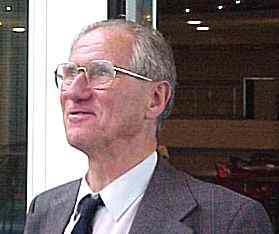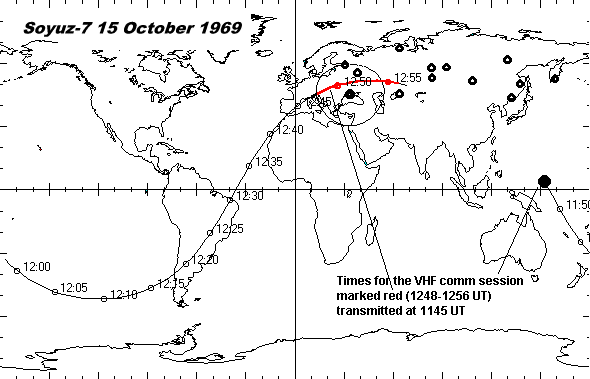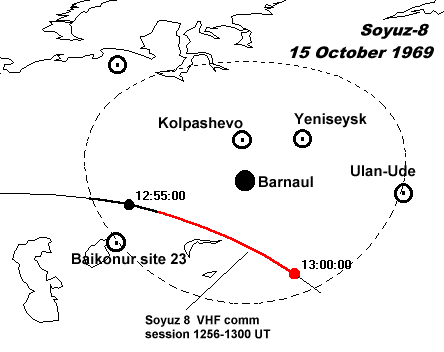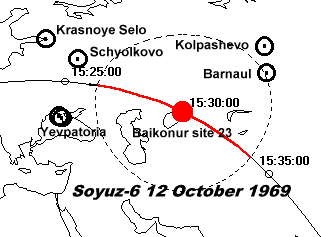 During
the Vostok and Voskhod flights shortwaves was used extensively to
communicate
with the cosmonauts. Often the communications were simplex, i.e. the
ground
and the spacecraft transmitted on the same frequency. Duplex was also
common.
During
the Vostok and Voskhod flights shortwaves was used extensively to
communicate
with the cosmonauts. Often the communications were simplex, i.e. the
ground
and the spacecraft transmitted on the same frequency. Duplex was also
common.
 During
the Vostok and Voskhod flights shortwaves was used extensively to
communicate
with the cosmonauts. Often the communications were simplex, i.e. the
ground
and the spacecraft transmitted on the same frequency. Duplex was also
common.
During
the Vostok and Voskhod flights shortwaves was used extensively to
communicate
with the cosmonauts. Often the communications were simplex, i.e. the
ground
and the spacecraft transmitted on the same frequency. Duplex was also
common.
However, during Soyuz flights very little HF downlink or uplink voice was detected on the announced frequencies (15.008 MHz, 18.035 and 20.008 MHz). I have always speculated that HF voice operated on unannounced frequencies and not on the official Soyuz HF frequencies . I found that this had indeed been the case out when I talked to Chris van den Berg at the International Astronautical Congress in Amsterdam 1999 (Picture on the right).
He told me about the Vjezna HF transmitter network transmitting uplink to early Soyuz crews. Especially, Chris had noted that they sent instructions to the crews on HF about when to keep in contact on VHF. Long messages and instructions were also uplinked on AM shortwaves. The HF stations were normally used as broadcast relay stations. In this HF ground station network the various site had the designation Vjezna and a number. Vjezna-1 up to Vjezna-6 have been noted. It is interesting that this uplink voice was extensively used, but very little downlink HF voice detected on still unknown frequencies? Anyway, Chris van den Berg wrote me a long message where he described his receptions of HF uplink thirty years ago. Here is an edited version of his fascinating account:
Chris van den Berg writes about his monitoring of the HF uplink:
"....The frequency
was
22.205
MHz. This transmitter almost continuously relayed the Radio Moscow
broadcast (even there was once a football match, which was interrupted
by Vjezna). Never understood this and also never got any
explanation
or confirmation, Russians I spoke about this did not know or did
not want to say anything. When there was a message for the cosmonauts
the
broadcast transmission stopped and then there followed a
call in CW (in fact A2, so modulated tone on carrier WSN-1,
transmitted
by wireless operator who did not have the usual skill of soviet
wireless
operators.) Followed by Vjezna-1
in phone. I found this frequency by 'searching', which I always
did,
not only for space flight frequencies. .... During the same period I
also
picked up Vjezna-4, for instance on 13 October 1969. On the
same strange frequency and with relays of radio Moscow
broadcasts......Sometimes
the incoming beacon signal [telemetry on 15 or 20 MHz, SG:s comment] in
the background of the operator of VSN-1 could be heard..."

The communications session with Soyuz-6 and -8 was planned after that Soyuz-7 and performed through the stations at Baikonur and Barnaul (see map below)

That Baikonur was an active ground station for VHF is evident from an order about VHF communications session at 1527-1534 UT relayed Vjezna-1 to Antey (Soyuz-6) on 12 October 1969. This time period agrees perfectly with a pass over Baikonur as can be seen from the map above.

An example of a more detailed operational message is that transmitted to Antey and Buran at 1245 UT on 12 October 1969 by Vjezna-1 and received, recorded and translated by Chris van den Berg:
"....Starting
operation.
Orbit launch nr. 21. The direction you get from Buran during the 20th
orbit.
191500. Start 195100 adjusting 0 telemetry on the second. Engines
DO Here is VSN-1 , how did you read? Antey, Antey write down a
radiogram
according to form 9. Nr. 112 starting operation , launch (or: start)
orbit
21, direction you get from Buran during the 20th orbit. Ts.V.U. . Time
to switch on the program 19100. Start 195100
Adjusting
0 telemetry on the 2nd engines DO. Antey report if towards the end the
Katushka antenna did not deploy. Antey report the results of the
experiment
A-16.